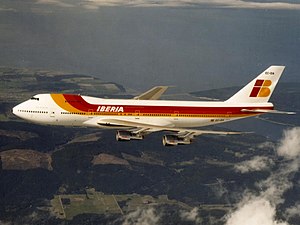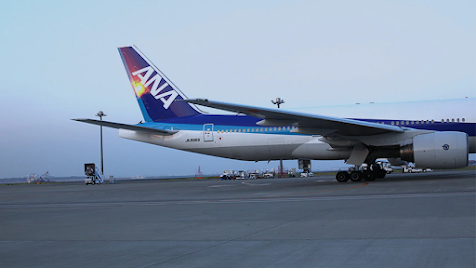Boeing 747
Boeing 747
| Boeing 747 | |
|---|---|
 | |
| The Boeing 747, here an Iberia 747-200, is a low-wing airliner powered by four turbofans, with a distinctive raised forward passenger deck and cockpit. | |
| Role | Wide-body jet airliner |
| National origin | United States |
| Manufacturer | Boeing Commercial Airplanes |
| First flight | February 9, 1969[1] |
| Introduction | January 22, 1970, with Pan Am[2][3] |
| Status | In service |
| Primary users | Atlas Air Lufthansa Cargolux UPS Airlines |
| Produced | 1968–present[a] |
| Number built | 1,571 (including prototype) as of May 2022[5] |
| Variants | Boeing 747SP Boeing 747-400 Boeing 747-8 Boeing VC-25 Boeing E-4 |
| Developed into | Boeing Dreamlifter Boeing YAL-1 Shuttle Carrier Aircraft SOFIA |
The Boeing 747 is a large, long-range wide-body airliner designed and manufactured by Boeing Commercial Airplanes in the United States. After introducing the 707 in October 1958, Pan Am wanted a jet 21⁄2 times its size, to reduce its seat cost by 30% to democratize air travel. In 1965, Joe Sutter left the 737 development program to design the 747, the first twin-aisle airliner. In April 1966, Pan Am ordered 25 Boeing 747-100 aircraft and in late 1966, Pratt & Whitney agreed to develop its JT9D engine, a high-bypass turbofan. On September 30, 1968, the first 747 was rolled out of the custom-built Everett Plant, the world's largest building by volume. The first flight took place on February 9, 1969, and the 747 was certified in December of that year. It entered service with Pan Am on January 22, 1970. The 747 was the first airplane dubbed "Jumbo Jet", the first wide-body airliner.
The 747 is a four-engined jet aircraft, initially powered by Pratt & Whitney JT9D turbofan engines, then General Electric CF6 and Rolls-Royce RB211 engines for the original variants. With a ten-abreast economy seating, it typically accommodates 366 passengers in three travel classes. It has a pronounced 37.5° wing sweep, allowing a Mach 0.85 (490 kn; 900 km/h) cruise speed, and its heavy weight is supported by four main landing gear legs, each with a four-wheel bogie. The partial double-deck aircraft was designed with a raised cockpit so it could be converted to a freighter airplane by installing a front cargo door, as it was initially thought that it would eventually be superseded by supersonic transports. Freighter variants of the 747 remain popular with cargo airlines.
Boeing introduced the -200 in 1971, with more powerful engines for a heavier maximum takeoff weight (MTOW) of 833,000 pounds (378 t) from the initial 735,000 pounds (333 t), for a longer 6,560-nautical-mile (12,150 km) range up from 4,620 nautical miles (8,560 km). It was shortened for the longer-range 747SP in 1976, and the 747-300 followed in 1983 with a stretched upper deck for up to 400 seats in three classes. The heavier 747-400 with improved RB211 and CF6 engines or the new PW4000 engine (the JT9D successor), and a two-crew glass cockpit, was introduced in 1989 and is the most common variant. After several studies, the stretched 747-8 was launched on November 14, 2005, with new General Electric GEnx engines, and was first delivered in October 2011. The 747 is the basis for several government and military variants, such as the VC-25 (Air Force One), E-4 Emergency Airborne Command Post, Shuttle Carrier Aircraft, and some experimental testbeds such as the YAL-1 and SOFIA airborne observatory.
By May 2022, 1,570 aircraft had been delivered, with three 747-8Fs remaining on order. Manufacture of the 747 is scheduled to end in 2022 after a 54-year production run. Initial competition came from the smaller trijet widebodies: the Lockheed L-1011 (introduced in 1972), McDonnell Douglas DC-10 (1971) and later MD-11 (1990). Airbus competed with later variants with the heaviest versions of the A340 until surpassing the 747 in size with the A380, delivered between 2007 and 2021. As of 2020, 61 Boeing 747s have been lost in accidents, in which a total of 3,722 people have died.
Development[edit]
Background[edit]
In 1963, the United States Air Force started a series of study projects on a very large strategic transport aircraft. Although the C-141 Starlifter was being introduced, officials believed that a much larger and more capable aircraft was needed, especially to carry cargo that would not fit in any existing aircraft. These studies led to initial requirements for the CX-Heavy Logistics System (CX-HLS) in March 1964 for an aircraft with a load capacity of 180,000 pounds (81.6 t) and a speed of Mach 0.75 (430 kn; 800 km/h), and an unrefueled range of 5,000 nautical miles (9,300 km) with a payload of 115,000 pounds (52.2 t). The payload bay had to be 17 feet (5.18 m) wide by 13.5 feet (4.11 m) high and 100 feet (30 m) long with access through doors at the front and rear.[6]
The desire to keep the number of engines to four required new engine designs with greatly increased power and better fuel economy. In May 1964, airframe proposals arrived from Boeing, Douglas, General Dynamics, Lockheed, and Martin Marietta; engine proposals were submitted by General Electric, Curtiss-Wright, and Pratt & Whitney. Boeing, Douglas, and Lockheed were given additional study contracts for the airframe, along with General Electric and Pratt & Whitney for the engines.[6]
The airframe proposals shared several features. As the CX-HLS needed to be able to be loaded from the front, a door had to be included where the cockpit usually was. All of the companies solved this problem by moving the cockpit above the cargo area; Douglas had a small "pod" just forward and above the wing, Lockheed used a long "spine" running the length of the aircraft with the wing spar passing through it, while Boeing blended the two, with a longer pod that ran from just behind the nose to just behind the wing.[7][8] In 1965, Lockheed's aircraft design and General Electric's engine design were selected for the new C-5 Galaxy transport, which was the largest military aircraft in the world at the time.[6] Boeing carried the nose door and raised cockpit concepts over to the design of the 747.[9]
Airliner proposal[edit]
The 747 was conceived while air travel was increasing in the 1960s.[10] The era of commercial jet transportation, led by the enormous popularity of the Boeing 707 and Douglas DC-8, had revolutionized long-distance travel.[10][11] In the early 1960s, even before it lost the CX-HLS contract, Boeing was asked by Juan Trippe, president of Pan Am, one of their most important airline customers, to build a passenger aircraft jet 21⁄2 times size of the 707.[12]
During this time, airport congestion, worsened by increasing numbers of passengers carried on relatively small aircraft, became a problem that Trippe thought could be addressed by a larger new aircraft.[13]
In 1965, Joe Sutter was transferred from Boeing's 737 development team to manage the design studies for the new airliner, already assigned the model number 747.[14] Sutter began a design study with Pan Am and other airlines to better understand their requirements. At the time, many thought that the 747 would eventually be superseded by supersonic transport aircraft.[15] Boeing responded by designing the 747 so it could be adapted easily to carry freight and remain in production even if sales of the passenger version declined.
In April 1966, Pan Am ordered 25 Boeing 747-100 aircraft for US$525 million[16][17] (equivalent to $3.3 billion in 2020 dollars). During the ceremonial 747 contract-signing banquet in Seattle on Boeing's 50th Anniversary, Juan Trippe predicted that the 747 would be "…a great weapon for peace, competing with intercontinental missiles for mankind's destiny".[18] As launch customer,[1][19] and because of its early involvement before placing a formal order, Pan Am was able to influence the design and development of the 747 to an extent unmatched by a single airline before or since.[20]
Design effort[edit]
Ultimately, the high-winged CX-HLS Boeing design was not used for the 747, although technologies developed for their bid had an influence.[21] The original design included a full-length double-deck fuselage with eight-across seating and two aisles on the lower deck and seven-across seating and two aisles on the upper deck.[22][23] However, concern over evacuation routes and limited cargo-carrying capability caused this idea to be scrapped in early 1966 in favor of a wider single deck design.[1] The cockpit was, therefore, placed on a shortened upper deck so that a freight-loading door could be included in the nose cone; this design feature produced the 747's distinctive "hump".[24] In early models, what to do with the small space in the pod behind the cockpit was not clear, and this was initially specified as a "lounge" area with no permanent seating.[25] (A different configuration that had been considered to keep the flight deck out of the way for freight loading had the pilots below the passengers, and was dubbed the "anteater".)[26]
One of the principal technologies that enabled an aircraft as large as the 747 to be drawn up was the high-bypass turbofan engine.[27] This engine technology was thought to be capable of delivering double the power of the earlier turbojets while consuming one-third less fuel. General Electric had pioneered the concept but was committed to developing the engine for the C-5 Galaxy and did not enter the commercial market until later.[28][29] Pratt & Whitney was also working on the same principle and, by late 1966, Boeing, Pan Am and Pratt & Whitney agreed to develop a new engine, designated the JT9D to power the 747.[29]
The project was designed with a new methodology called fault tree analysis, which allowed the effects of a failure of a single part to be studied to determine its impact on other systems.[1] To address concerns about safety and flyability, the 747's design included structural redundancy, redundant hydraulic systems, quadruple main landing gear and dual control surfaces.[30] Additionally, some of the most advanced high-lift devices used in the industry were included in the new design, to allow it to operate from existing airports. These included Krueger flaps running almost the entire length of the wing's leading edge, as well as complex three-part slotted flaps along the trailing edge of the wing.[31][32] The wing's complex three-part flaps increase wing area by 21% and lift by 90% when fully deployed compared to their non-deployed configuration.[33]
Boeing agreed to deliver the first 747 to Pan Am by the end of 1969. The delivery date left 28 months to design the aircraft, which was two-thirds of the normal time.[34] The schedule was so fast-paced that the people who worked on it were given the nickname "The Incredibles".[35] Developing the aircraft was such a technical and financial challenge that management was said to have "bet the company" when it started the project.[1]
Production plant[edit]
As Boeing did not have a plant large enough to assemble the giant airliner, they chose to build a new plant. The company considered locations in about 50 cities,[36] and eventually decided to build the new plant some 30 miles (50 km) north of Seattle on a site adjoining a military base at Paine Field near Everett, Washington.[37] It bought the 780-acre (320 ha) site in June 1966.[38]
Developing the 747 had been a major challenge, and building its assembly plant was also a huge undertaking. Boeing president William M. Allen asked Malcolm T. Stamper, then head of the company's turbine division, to oversee construction of the Everett factory and to start production of the 747.[39] To level the site, more than four million cubic yards (three million cubic meters) of earth had to be moved.[40] Time was so short that the 747's full-scale mock-up was built before the factory roof above it was finished.[41] The plant is the largest





Comments
Post a Comment